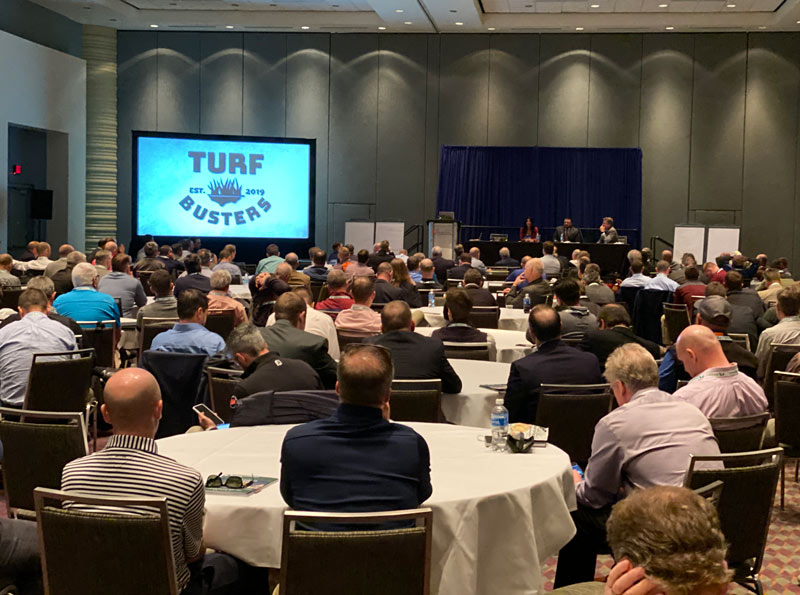
The “Turf Busters” hold court at the 2020 Golf Industry Show. Their goal: Unlock the truth behind a few of golf’s frequently debated topics. Photo by Roger Billings
Mike Richardson, Ph.D., was hoping for a non-hostile crowd at the Orange County Convention Center.
“I hope nobody brought rotten fruits or vegetables to throw at us,” Richardson said.
Judging by the laughter from the audience, he and his cohorts — GCSAA Class A superintendent Sean Reehoorn and Gina Rizzi, president of ARCUS Marketing Group — had no need to worry. The three were on hand to present “Myth Busters, Turf Edition” at the 2020 Golf Industry Show, a free education session focused on providing as much substantial information as possible to help superintendents separate fact from myth and, in turn, improve their operations.
The trio floated three matters for discussion.
1. When it comes to aerification of USGA greens, deep-tine aerification is best.
The team tested green sand 12 inches deep, analyzing it for porosity, infiltration and organic matter. Reehoorn, a 16-year GCSAA member who oversees Aldarra Golf Course in Sammamish, Wash., uses a deep-tine tool to aerify. Richardson isn’t necessarily a big fan of the practice, and the test showed why. “All changes happened in the top 4 inches. What does that mean? If you punch out 8 more inches, you’re taking out really good sand, and it’s costing time and money,” Richardson said.
Verdict? Myth!
2. There is a right way to repair a ball mark.
The gang went to great lengths to investigate how golfers tackle ball marks. They showed a video of themselves out on the course, trying to be inconspicuous by standing behind a large tree adjacent to a green as they eyed golfers fixing their ball marks. Each of the three golfers observed used the two-prong repair tool.
The audience got into the ball-mark-mending conversation, with one attendee sharing that his course’s golf professional had shown members a short video about how to repair their ball marks. The result? Members’ diligence regarding the matter lasted about a month.
Richardson, who is a turfgrass professor in the Department of Horticulture at the University of Arkansas, said a superintendent in his state stations himself on a par 3 during the tournaments he hosts to instruct golfers on how to do repair work. “Use every opportunity you can to educate your golfers,” Richardson said.
Verdict? There’s not necessarily one best way to repair ball marks. What matters is that one makes an attempt, as ball marks left unaddressed can create unhealthy turf.
3. Street dogs are faster than turf dogs.
Full disclosure: The entire panel admitted that the Labrador retriever “street dog” who raced Reehoorn’s dog, Porter (a mix of border collie, boxer, Saint Bernard and more), was not the same weight as Porter, which may be one reason why Porter finished with a faster time in a race in which the Labrador ran on a hard surface while Porter sprinted on turfgrass.
This attempt at settling the street dog vs. turf dog myth may have more bark than bite. “The validity of these results are somewhat questionable,” Richardson said with a grin.
Verdict? Myth — in this case!
Howard Richman is GCM’s associate editor.